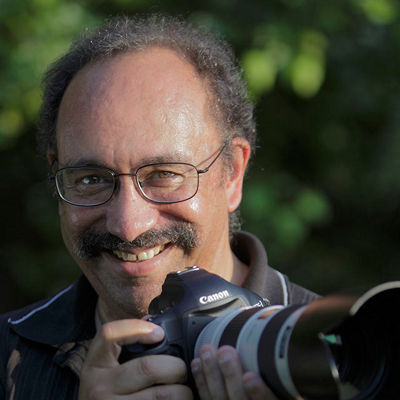The EOS M50 is arguably one of the most impressive entry-level cameras from Canon, and it brings a lot more than compact size and lens interchangeability to the user stepping-up to a full-featured camera. In this article, we’ll discuss the advancements in its AF system, which in some ways place it ahead of existing models that target the more advanced user.
Dual Pixel CMOS AF, Refined and Advanced
Canon’s outstanding and proven Dual Pixel CMOS autofocus technology is used on the EOS M50. From the start, this is a tremendous technological foundation for strong focus performance, for both still and video shooting. Unlike most competitive focus systems, Dual Pixel CMOS AF uses every pixel on the camera’s imaging sensor for both focus detection and image recording. (With many competitive models, a series of spread-out, individual pixels on the image sensor are used exclusively for focus detection; the “blank” information for actual image recording from those select pixels is filled-in during processing, using color and brightness information from neighboring pixels.)

With Canon’s Dual Pixel CMOS AF technology, every pixel on the imaging sensor is used to gather focus information, before each picture is taken. In this conceptual illustration, the actual light-sensitive photodiode area of each pixel is split into two halves, shown here as red and blue. Each separately gathers and generates focus information, before a shot is taken. Then, during actual exposure, the data from each half is combined, so for imaging purposes, the two halves act as one single pixel. Dual Pixel CMOS AF is especially important in a mirrorless-type camera, because unlike traditional DSLRs, there’s no separate AF sensor — AF detection is always done off the imaging sensor in the EOS M50.
By using each and every pixel for focus detection, far more sharpness information is gathered, and the result is extremely smooth, positive focus movement. This is especially important in a “mirrorless” camera, since off-the-image sensor focus is essentially the only method available for focusing…traditional digital SLRs are able to use an entirely separate, dedicated AF sensor for focus detection when you shoot via their eye-level viewfinders. HD video recording is an area where the Dual Pixel CMOS technology has proven to be especially effective, with both moving and non-moving subjects.
But the EOS M50 brings new features and performance to this established Dual Pixel CMOS technology. We’ll explore each of these in more detail in this article:
- Big increase in AF points: 99 points available with most EF-M lenses; 143 AF points with select EF-M lenses
- Larger overall area for AF coverage — 100% of the vertical dimension of the frame, and up to 88% of the horizontal space are available for AF, with select EF-M lenses
- Superior focus tracking performance, with wider area of focus coverage, when shooting moving subjects
- New: Eye-detection AF, which can detect and focus upon the eye nearest to the camera when human faces are detected
- Superior low-light AF capability — AF sensitivity improved by approximately one stop, vs. EOS M5 camera
- Continuous, Servo AF allows shooting moving subjects at up to 7.4 fps — fastest shooting speed with continuous AF to date on an entry-level, interchangeable lens Canon EOS camera*
AF over a Broader Area than any Previous EOS M-series Model
The EOS M50 allows focusing over more of the picture area than all previous EOS M-series models, as of January 2018 — when compatible lenses are used (see immediately below).
And, when this enlarged AF area is available, the number of AF points expands greatly — to 149 AF points (vs. 49 points on EOS M5, M6, and M100 models).
Compatible EF-M lenses for enlarged AF area, and 149 AF points:
EF-M 18–150mm f/3.5–6.3 IS STM
EF-M 55–200mm f/4.5–6.3 IS STM
EF-M 28mm f/3.5 Macro IS STM
With remaining EF-M lenses, there are still benefits — the number of AF points is now 99, within the same smaller 80% x 80% (horizontal x vertical) area of the image. Previous EOS M-series cameras used only 49 AF points, over that same 80% x 80% area of the picture.
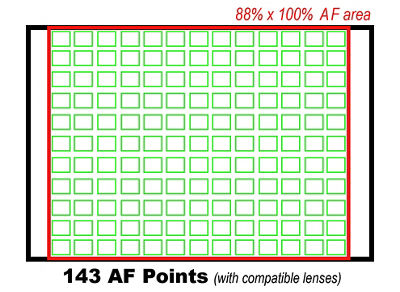
The EOS M50 expands the area covered (see red outline), and within it, breaks the area into finer segments for focus, with 143 distinct AF points available. This makes AF possible over more of the picture area than any EOS M-series camera to date. For technical reasons, this expanded coverage is available (as of February 2018) with the EF-M 18–150mm, 55–200mm, and 28mm Macro lenses only.
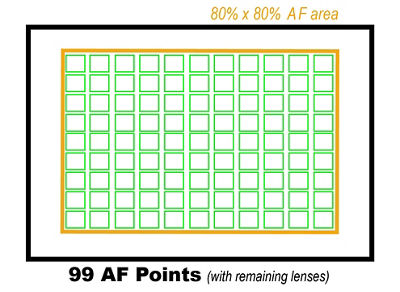
With other EF-M lenses, the total area covered for AF is the same 80% x 80% (horizontal x vertical) area used with previous EOS M-series cameras, such as the EOS M100, M6, and M5. However, the EOS M50 again breaks this active area into finer segments, and thus 99 individual AF points are available. Compare this graphic to the one below, which shows the previous 49-point AF system.
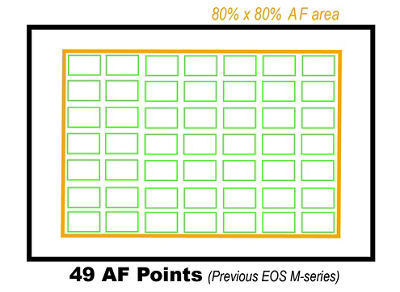
Previously-introduced EOS M-series “mirrorless” cameras used 49 separate AF points, spread out in an area for AF that covered 80% x 80% (horizontal x vertical) of the entire picture area — shown here by the orange-colored outline.
What this means is that the casual, beginning photographer using the EOS M50 will be able to quickly shoot subjects even further off-center, with lenses such as the EF-M 18–150mm. Moving subjects can be tracked around an even larger area of the scene. More precise selection of where to focus will be possible, with more available AF points, smaller in size. And as their experience grows, the advancing user can change the AF Method to a smaller, more precise single AF point for subjects ranging from portraits to sports or wildlife.
New for Canon — Eye Detection AF
This is an exciting new feature, introduced with the EOS M50 camera. When its AF Method is set to Face Detect + Tracking, the entire active AF area (see the colored outlines in the graphics above) is used for focusing. And, if a human face is detected, the Face Detect technology has been enhanced — the camera doesn’t simply focus on the most prominent face in the scene. Instead, it now is able to detect the nearest eye on that face, and puts a smaller focus box on that eye. If that person moves around the picture area, the Eye Detection AF continues to track that eye, as long as it remains visible.
When Eye Detection AF is active, you’ll see a large, outer box indicating that Face Detection has recognized a human face. And within it, a smaller box will surround the actual eye that is being concentrated upon for Eye Detection AF — such as in the following simulated graphic:
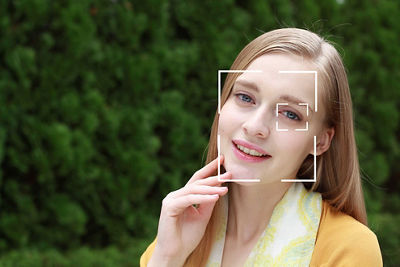
This means that sharp focus will more than ever be placed on the “leading” eye of your subjects, whether you’re shooting portraits or candid pictures. Where many experienced photographers might have previously made the effort to change to a single AF point, and move it manually to cover the face of a human subject, the new Eye Detection AF technology means that the process can be left to the EOS M50 in many cases.
All that has to be done to activate Eye Detection AF is to Enable Eye Detection AF in the 3rd Shooting Menu screen, and be sure that Face Detect + Tracking is the active AF Method. It will function in most shooting modes.
While Eye Detect AF will normally focus upon the eye nearest to the camera, if you want to concentrate on the subject’s other eye, that’s easy to do — just press the AF Point Select button, on the back of the camera, twice. You’ll see the smaller “box” surrounding the detected eye jump to the subject’s other eye.
For Face Detection AF, and the more advanced Eye Detection AF to function, the camera basically has to be able to identify typical human facial features — two eyes, a nose, and a mouth. Accordingly, there can be some limits to the EOS M50’s Eye Detection AF:
- It will not function with Servo AF, so it’s unable to work with moving subjects (therefore, Eye Detection AF is not possible in Sports Mode or Panning Mode). Additionally, it’s disabled if you’re using the Miniature effect or Fish-eye effect settings, within the Creative Filters modes.
- Eye Detection AF cannot be used when recording video (overall Face Detection is possible during video recording, including when continuous Movie Servo AF is active).
- The primary face in the scene needs to be sufficiently close to take up a certain amount of space in the picture — if a detected face is too distant or small in the frame, the EOS M50 will revert to conventional Face Detection, and you won’t see the smaller “box” displayed over a subject’s eye before you take the picture.
- Eye Detect AF may have problems if the subject’s eyes are partially or fully closed.
- The primary face needs to be turned so it’s essentially facing toward the camera, and the eyes need to be somewhat in the camera’s direction as well. While direct eye contact with the camera isn’t required, if the subject’s eyes are angled significantly to one side or the other, the EOS M50’s Eye Detection AF may not be able to detect the eye nearest the camera (again, it will usually revert to ordinary Face Detection, or conventional Automatic AF point selection).
- If one or both of the subject’s eyes are in deep shadow, Eye Detection AF (and sometimes overall Face Detection AF) may have difficulty functioning.
- Sunglasses, excessive make-up around the eyes, masks, and so on will usually prevent the Eye Detection AF from being able to detect and focus upon the nearest eye. And, like Face Detection, it’s designed to detect human eyes… it normally will not work with animals or other non-human subjects.

The EOS M50’s Eye Detection AF is a superb new feature, and a first for Canon EOS cameras. But be aware that if the subject’s face (or eyes) are turned significantly away from the camera, the Eye Detection may not be able to function. In such cases, the AF system will revert to conventional Face Detection AF, or if a face cannot be detected at all, to Automatic AF point selection.
All that said, the EOS M50’s Eye Detection AF is a cool new feature, a first for Canon EOS cameras, and has the potential to really enhance the camera’s focus performance when photographing people.
Enhanced AF Performance with Moving Subjects
Powering the EOS M50 is another Canon EOS first — the DIGIC 8 processor. With faster calculation times and added ability to perform multiple tasks, this new processor brings benefits to the M50’s focusing, when working with moving subjects.
- Superior focus tracking Focus tracking is the camera’s ability to continue to maintain sharp focus, as a subject moves around the frame — left, right, up, and/or down. This is more than simply continuous focus upon a subject moving toward the camera. Focus tracking means the camera is able to continually change focus points, to keep the subject in sight, and in sharp focus.
- Servo AF at speeds up to 7.4 fps The faster AF calculation performance in the EOS M50 likewise means Servo AF performance — its ability to continually focus on moving subjects in general — exceeds that of all previous EOS M-series cameras, as of February 2018. Its ability to shoot up to 7.4 frames per second, with continuous AF for each frame, means this camera arguably has the best action-oriented AF of any entry-level Canon EOS camera to date (this includes EOS M-series cameras introduced prior to 2018, as well as EOS Rebel models introduced up to this time).
Superior Low-light AF Detection and Performance
EOS M50 is able to focus reliably in scenes as dim as EV -2. Putting that into practical terms, that’s a light level equivalent to an ISO 3200 scene, shot at 4 full seconds, at f/5.6 — similar to what you might encounter photographing a moonlit landscape in some situations. Armed with one stop more low-light AF capability than predecessors like the EOS M5 camera, the M50 offers great potential to beginning photographers and enthusiasts who want to experiment with night-time photos, indoor candids without flash, and similar opportunities when daylight can’t be taken for granted.
Summary
The EOS M50 targets the photographer stepping-up to his or her first interchangeable lens camera. But make no mistake — this is not a stripped-down, entry-level camera. And its autofocus performance is one of the primary areas where even knowledgeable and experienced photographers will readily see this camera’s potential. Autofocus historically has been an area where compact, mirrorless-type cameras have encountered challenges — such as continuously focusing on moving subjects, with telephoto lenses — but the EOS M50 is equipped to handle many of these adeptly. We encourage prospective users to pick this camera up, experiment with its ability to focus decisively, try features like its Eye Detection AF, and experience this powerful AF system for yourself.




